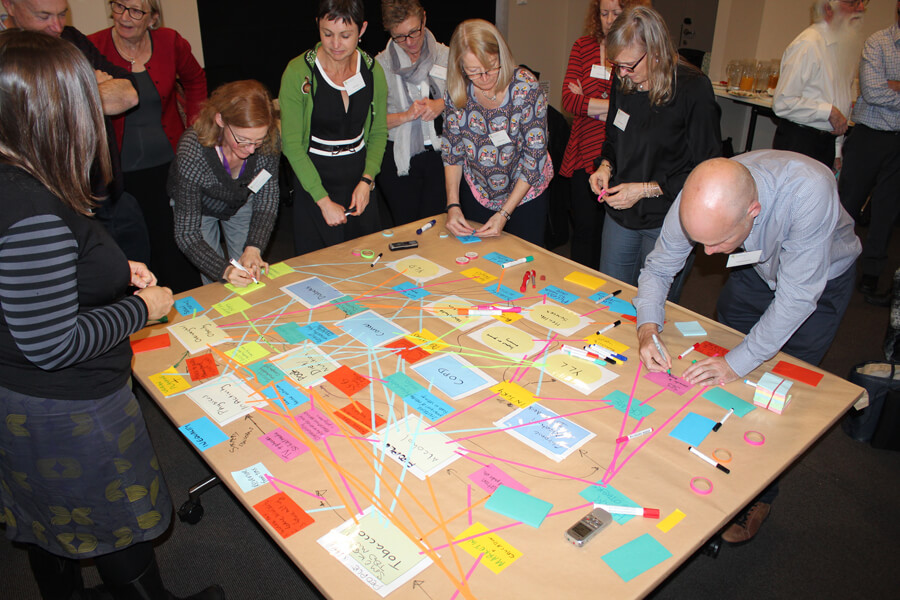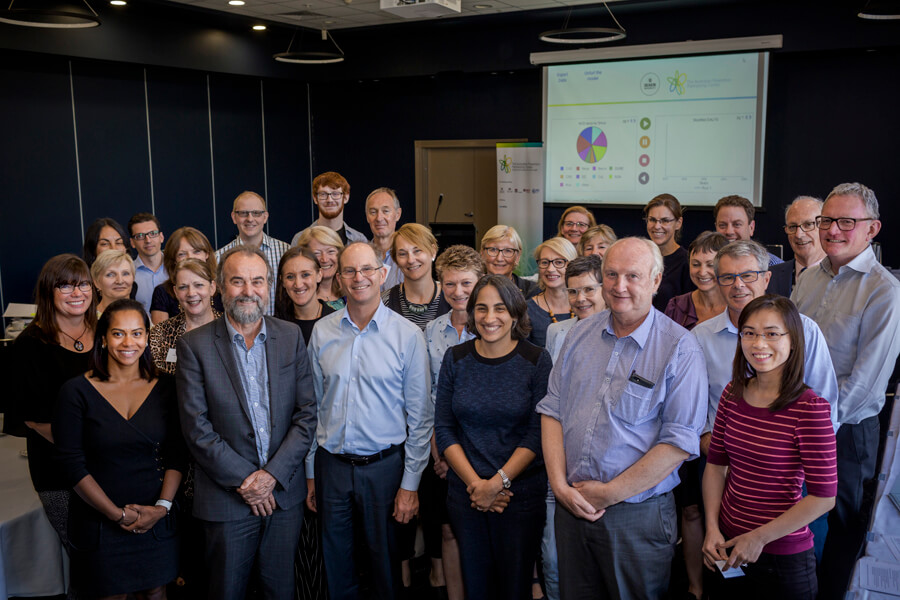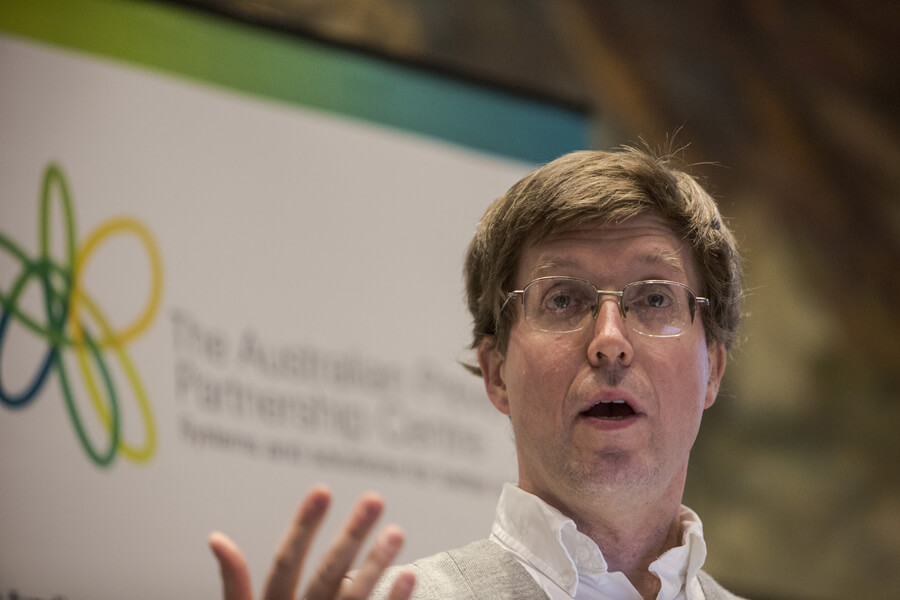Dynamic simulation modelling
Complex, ‘wicked’ public health problems pose a range of challenges that can prevent effective action by decision makers. The Prevention Centre is promoting the use of dynamic simulation modelling in health to provide policy makers with a unique ‘what if’ tool to test the likely impact of a range of possible solutions before implementing them in the real world to help prevent chronic disease in Australia.

Page contents
What is dynamic simulation modelling?
Dynamic simulation models are virtual, simplified representations of the real world where actions and reactions of individuals and communities can be explored, helping us to understand how people develop health conditions, use health services and which public health interventions are likely to be effective, in which contexts and at what scale.
Informed by a variety of evidence sources such as research, expert knowledge, practice experience and population-based behavioural and demographic datasets, the models can represent complex human behaviours. They can follow individuals throughout life, identifying how their influences and behaviours change, and how their health is impacted over time.
They can also map the aggregate effects of thousands of people operating in a complex system, following their interactions and responses to different policies and interventions.
Video explaining dynamic simulation modelling
A dynamic simulation model is a ‘what if’ tool through which we can test various policy scenarios over time to see which are likely to have the most effect, both on individuals as well as on the system as a whole.
Watch this 2-minute video for a concise explanation of how dynamic simulation modelling is a low-risk, low-cost way of testing various policy scenarios into the future.
Why use dynamic simulation modelling in chronic disease prevention?
The solutions to complex public health problems such as harmful alcohol consumption, overweight and obesity and mental disorders remain elusive, despite hundreds of millions of dollars and decades of research that have led to attempts to combat them through ‘evidence-informed’ policy.
Traditional analytic tools for supporting evidence-informed policy are limited in their ability to help policy makers to plan and make decisions.
Computer simulation models provide us with a framework for mapping and quantifying complex problems. They provide a relatively low cost and risk-free way of testing the likely impacts and costs of different options for intervening before implementing them in the real world.
Although dynamic simulation modelling has been used successfully in engineering, ecology, defence and business for many years, its value for health policy and planning is being increasingly recognised.
The Prevention Centre uses a unique participatory, transparent approach to dynamic simulation modelling.
We work collaboratively with our project partners, policy agencies, researchers and other stakeholders to build the logic and obtain the data and evidence inputs that inform our models. This gives our policy partners confidence in the models’ integrity and validity. It also provides partners with a level of ownership, ensuring they are more likely to interact with the tool and use it to build policy evidence.
Related publications
-
Knowledge mobilisation for policy development: implementing systems approaches through participatory dynamic simulation modelling
-
A modelling tool for policy analysis to support the design of efficient and effective policy responses for complex public health problems
-
Decision makers’ experience of participatory dynamic simulation modelling: methods for public health policy
Dynamic simulation models for public health
Here are six examples of ways that the Prevention Centre is promoting the use of dynamic simulation modelling.
Developing a compelling case for prevention with the GoHealth model
This exploratory project developed a national dynamic simulation model of chronic disease prevention, the GoHealth model. Based on trends in prevalence of nine modifiable risk factors, the model aimed to project the health burden and economic costs of preventable disease in Australia and allow scenario testing to understand how best to allocate investments and actions across risk factors to achieve the greatest impacts on chronic disease.
To the best of our knowledge, the GoHealth model is the first dynamic simulation model in the world that captures the dynamic relationships between risk factors for chronic disease in a comprehensive way and links these to burden of disease and associated economic costs.
Download a PDF Findings Brief on the model and to register interest in a preview of the GoHealth model.

World leading tripartite simulation model to support decision making in gestational diabetes care
This model incorporated multiple methods including agent-based modelling, system dynamics and discrete event simulation into a logically consistent decision support tool for health policy and program decision making. The model incorporates best available evidence, data and expert opinion reinforcing the long-term benefits for women and their children of preventing diabetes in pregnancy.
Download a PDF factsheet on preventing diabetes in pregnancy using a dynamic simulation model for further detail and resources around this research project.

Simulation model of alcohol consumption and the effectiveness of harm-reduction policies
A Prevention Centre dynamic simulation model of alcohol use in Tasmania is directly informing Tasmania’s forthcoming Alcohol Action Framework. The modelling process has helped develop new ways of thinking about tackling complex issues like harmful alcohol consumption as well as bringing together stakeholders including alcohol and drugs services, youth services, the Liquor Commission, Treasury, Police and the Education Department.
Read our Findings Brief for more detail about how this project used a participatory process to develop the dynamic simulation model around alcohol-related harms.

System dynamics modelling to inform strategic planning for achieving the NSW Premier’s target for reducing childhood overweight and obesity
A dynamic simulation model developed in partnership with NSW Health has helped inform strategic planning for the NSW Premier’s Priority on childhood overweight and obesity. The model was built to forecast which combinations of policies and programs would be needed to achieve the Premier’s target of reducing childhood overweight and obesity by 5% within 10 years.
Download our Findings Brief for more details about how a collaborative approach helped build trust and engagement in the model.

Modelling strategies to reduce smoking in Queensland
The Queensland Government commissioned a dynamic simulation model to inform its smoking reduction strategy by identifying and testing key priority interventions to see which are most likely to make an impact.
Read a news article about our dynamic simulation model developed to inform Queensland Government’s smoking reduction strategy.

Modelling smoking behaviour and its influence on COPD in New South Wales
The research simulation study utilised the data from adults in NSW and Australia including the data from the Sax Institute’s 45 and Up Study. The model captures detailed smoking behaviours, including smoking intensity, cessation rate and length, and relapse. The outcomes elucidate influence of smoking cessation attempt on incidence and prevalence of COPD by stage of the disease.
Download a Findings Brief on the first model in Australia to develop a dynamic simulation model to forecast the population health implications of smoking behaviour on COPD over the next 50 years.

Frequently asked questions about dynamic simulation modelling
Dynamic simulation modelling can answer important questions, such as which risk factors are the most important, at what stages of people’s lives we should target interventions, and which combinations of interventions work best, are most equitable and most cost-effective.
- It offers a way of helping to better focus resource allocation for optimal impact
- It helps policy makers to test big decisions in the virtual world before implementing them in real life
- It enables us to better understand the dynamics of populations, their behaviours and outcomes over time
- It is low risk and relatively low cost: We can test what works without the expense and ramifications of trialling new or multiple interventions in the real world
- There is potential to include many possible effective interventions and select different combinations
- We can test the impact of alternative interventions in situations where research consensus has not been reached
- In situations where the likely impact of different combinations of interventions is difficult to predict, the model can provide insights into potential synergistic, additive or lagged effects.
The Prevention Centre two main modelling approaches: System Dynamics and Agent-based modelling.
- System dynamics is a system modelling engineering tool that has been in use for over 60 years. It is a quantitative tool that was initially used in industrial management, and which is now commonly used in manufacturing, process-oriented industries, and defence logistics planning and asset lifespan. Today, system dynamics is widely used in climate science as a tool that incorporates ‘what if’ assumptions to analyse the impact of changes on our climate system, from sea level rises to historic temperature change and global CO2. System dynamics takes an aggregate, population level perspective, considering flows, feedback loops and time-delays in a complex system.
- Agent-based, often called individual-based, models simulate the actions and interactions of individuals (‘agents’) in order to generate insights into the impact of their health and social behaviours on themselves and the wider population. These models use data or evidence to tailor the demographic characteristics, exposures, and behavioural rules that drive individual behaviours and health outcomes. Agent-based models can be developed with hundreds of thousands individual agents and are valuable for exploring equity issues such as the differing effects of exposures and interventions on the health outcomes of sub-populations
Our dynamic simulation models can test interventions before they are implemented in the real world. They provide reliable forecasts and insights into:
- Which risk factors are the most important to target for the prevention of chronic disease and how do they interact?
- What can be achieved by intervening on (or targeting) one risk factor, or a combination of risk factors?
- What combination of interventions is likely to be effective and at what scale are they needed?
- Are there leverage points in the system (places in the system where small changes can lead to large shifts in outcomes)?
- Are there times or life stages that are important for targeting interventions?
- We work collaboratively with academics, policy makers and practitioners to map the key risk factors and likely causal pathways leading to the health or economic outcomes we are interested in. This information is combined with empirical evidence and administrative, survey and burden of disease data to create a computer model that can explore complex health issues.
- We test the model to ensure it accurately represents the population of interest. We can model anything from small sections of the community in different geographic locations to the population of the entire country.
- We produce a baseline to see what would happen with no new interventions (business as usual).
- Using a simple interface, different interventions can be selected individually or in combination, and targeted in different ways to explore how this is likely to impact the outcomes over the short and long term.
Once our models are completed, we have the option of sharing them amongst our key policy agency partners via easy-to-use web browser interfaces or exporting results to statistical programs for further analysis.
Our experts in dynamic simulation modelling
-
Associate Professor Louise Freebairn
The University of Sydney, ANU -
Dr Danielle Currie
The Sax Institute -
Associate Professor Jaithri Ananthapavan
Deakin University -
Paul Crosland Paul Crosland has finished working with the Prevention Centre.
The University of Sydney -
Jacqueline Davison
The Sax Institute
Modellers
-
Dr Geoff McDonnell
The Sax Institute -
Dr Ante Prodan Dr Ante Prodan has finished working with the Prevention Centre.
The Sax Institute -
Professor Nathaniel Osgood
University of Saskatchewan -
Simon Chiu
The Sax Institute
Select publications on our dynamic simulation models
-
‘Turning the tide’ on hyperglycemia in pregnancy: insights from multiscale dynamic simulation modeling
TypePublications
Date -
Turning conceptual systems maps into dynamic simulation models: An Australian case study for diabetes in pregnancy
TypePublications
Date -
Systems modelling tools to support policy and planning
TypePublications
Date -
Impacts of licensed premises trading hour policies on alcohol-related harms
TypePublications
Date -
Can the Target Set for Reducing Childhood Overweight and Obesity Be Met? A System Dynamics Modelling Study in New South Wales, Australia
TypePublications
Date -
Harnessing advances in computer simulation to inform policy and planning to reduce alcohol-related harms
TypePublications
Date -
Dynamic simulation modelling of policy responses to reduce alcohol-related harms: rationale and procedure for a participatory approach
TypePublications
Date -
Knowledge mobilisation for policy development: implementing systems approaches through participatory dynamic simulation modelling
TypePublications
Date -
Participatory simulation modelling to inform public health policy and practice: Rethinking the evidence hierarchies
TypePublications
Date -
Simulation modelling as a tool for knowledge mobilisation in health policy settings: a case study protocol
TypePublications
Date -
A modelling tool for policy analysis to support the design of efficient and effective policy responses for complex public health problems
TypePublications
Date -
Applications of system dynamics modelling to support health policy
TypePublications
Date
News stories and impact about dynamic simulation models
-
Making a compelling case for prevention
The Prevention Centre’s interdisciplinary research team has developed a dynamic simulation model to demonstrate the value of reducing risks for chronic health conditions. -
Australia’s first national model of chronic disease burden
A Prevention Centre project has highlighted the potential of dynamic simulation modelling for policy makers to demonstrate the value of prevention and its associated impact on costs and health outcomes. -
Keep a ‘human in the loop’ when using big data for health policy
If there’s one thing we can learn from Centrelink’s use of big data to recover debt, governments need to avoid action based purely on automated use of technologies, says internationally respected health data science expert Professor Nate Osgood. -
PhD project builds network to tackle diabetes in pregnancy
A Prevention Centre-funded PhD project has led to the development of a network of senior clinical experts, academics and dynamic systems modellers who are working together to tackle diabetes in pregnancy in the ACT. -
Informing the NSW Premier’s Priority on childhood overweight and obesity
A dynamic simulation modelling tool developed in partnership between the Prevention Centre and policy makers is being used to predict which policies will work. -
Building a local workforce of dynamic modellers
The Prevention Centre is building the capacity of Australian policy makers and academics to use dynamic simulation modelling techniques to address complex public health problems. -
Informing Tasmania’s Alcohol Action Framework
A Prevention Centre dynamic simulation model of alcohol use in Tasmania is directly informing Tasmania’s forthcoming Alcohol Action Framework.















